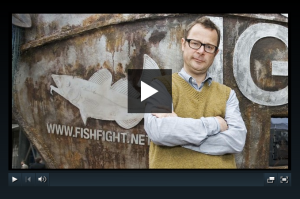How the campaign to reform the Common Fisheries Policy used emotional connection to bring a ‘complex’ campaign issue to the attention of the public across Europe.
I’m sure I’m not the only one who has Hugh Fearnley Whittingstall to thank for helping to demystify to relatives and friends what a campaigner does all day!
His latest series, Fish Fight, which was shown earlier in the year but returned with an update show in August, focused on the need to reform the Common Fisheries Policy, and deployed many of the campaign tactics that I’ve used in my work for the last few years. We had petitions, stunts, celebrity involvement, policy research and direct lobbying.
 One of the tactics that Hugh tried to employ in the series was the ‘exposure visit’ when he invited Richard Benyon, the relevant Government Minister to go out with fishermen to see first hand the waste caused by discards of fish.
One of the tactics that Hugh tried to employ in the series was the ‘exposure visit’ when he invited Richard Benyon, the relevant Government Minister to go out with fishermen to see first hand the waste caused by discards of fish.
He wasn’t able to get the minister to go onto a boat in the end, but the rationale seemed to be that if he could confront the Minister with the reality of the situation then he would be compelled to put his support behind action to reform the CFP.
I’ve heard of stories of other ministers and officials who’ve had their view changed on a subject or seen the importance of acting on a previous unconsidered issue, as the result of first hand exposure visit like this. A high-risk, high-reward tactic.
But with some targets that personal engagement isn’t going to be possible, and that’s why I really like this case study about Angela Merkel’s Fish Hut from Chris Rose (and I highly recommend you subscribe to his monthly newsletters). 
Faced with the same campaign issue at Fearnley Whittingstall, but with the need to mobilise public option in Germany, based on the critical role that Germany would have in the CFP negotiations but will little public support for action at present.
Now, it’s probably not possible to create a new emotional engagement with the issue for the German Chancellor, but thorough research showed a previous narrative that they could draw upon to help raise awareness to the German public.
Rose explains, ‘I asked our team if they could find an emotional connection between Merkel and fish. They came back with The Hut, which turns out to have played an iconic role in her political career, indeed without which she might never have been elected, and re-elected, and re-elected… ‘
It turns out that ‘The Hut’ was somewhere that Merkel had met with five fishermen in their hut at Lobbe, a small village on the island of Rugen, in her constituency in her first election campaign. The image was captured in a photograph that has over time gained a certain iconic status. So much so that she’s returned to the Hut and the fishermen she met back in 1990 on a number of occasions since.
So the campaign decided to create a replica hut and Rose explains ‘Rostock is its first stop, and then we hope to move on to Berlin. This way Mrs Merkel won’t have to travel back to her constituency to get in touch with the state of the fishing industry, it can come to her.’
Rose reflected ‘most NGO campaigns deal with the significant but a major difficulty in ‘selling’ their stories within a newspaper, is that many are not seen as very ‘interesting’. The CFP reform process has this problem to the max‘.
Going on to suggest that The Hut might overcome that ‘We hope that people, even the media, will find The Hut interesting. It has a story: about real people, about their hopes and fears and their relationship with power. You don’t need to be an expert to understand that the fate of fish and fishermen are inter-dependent‘.
A good lesson in the opportunity that finding an emotional connection between your campaign target and issue.